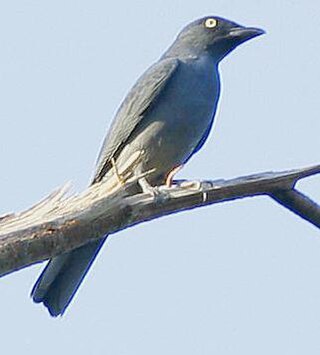
Richard Bowdler Sharpe was an English zoologist and ornithologist who worked as curator of the bird collection at the British Museum of natural history. In the course of his career he published several monographs on bird groups and produced a multi-volume catalogue of the specimens in the collection of the museum. He described many new species of bird and also has had species named in his honour by other ornithologists including Sharpe's longclaw and Sharpe's starling.

The Indian cuckooshrike is a species of bird in the cuckooshrike family Campephagidae that is found on the Indian subcontinent. Formerly under the English name "large cuckooshrike" this species included many subspecies and had a large range that included Southeast Asia.

Chlorocichla is a genus of songbird in the bulbul family, Pycnonotidae. They are mainly present throughout the African tropical rainforest, excepted the yellow-bellied greenbul, native to the miombo woodlands.

The white-throated greenbul or white-throated bulbul, is a species of passerine bird in the bulbul family, Pycnonotidae. It is widespread across the African tropical rainforest. It was formerly considered to be conspecific with the Angola greenbul.

Coracina is a large genus of birds in the cuckooshrike family Campephagidae.

The south Melanesian cuckooshrike is an uncommon species of bird in the cuckooshrike family. It is found in New Caledonia, Bougainville Island, the Solomon Islands, and Vanuatu. The species is a large (32–37 cm) cuckoo-shrike with a long square tail and all over dark grey plumage. The eye of adults is yellow, whereas that of the juvenile is dark. Its natural habitats are subtropical or tropical moist lowland forests and subtropical or tropical moist montane forests.

The Oriental cuckooshrike is a species of bird in the family Campephagidae. It is widely distributed from the Himalayas through Southeast Asia to east China and Taiwan. It is also found on the islands of Java and Bali in Indonesia. Its natural habitat is subtropical or tropical moist lowland forest. The range of this species was formerly restricted to Java and Bali and had the English name "Javan cuckooshrike".

The bar-bellied cuckooshrike is a species of bird in the family Campephagidae. It is found in Thailand, Malaysia, Indonesia, and the Philippines, and its natural habitats include mangrove forest, dry forest, swamp forest, and secondary forest. The plumage varies among the subspecies, with different amounts of barring on the underparts. The International Union for Conservation of Nature (IUCN) has assessed the species as one of least-concern.

The large niltava is a species of bird in the Old world flycatcher family Muscicapidae. It is found in Bangladesh, Bhutan, Cambodia, China, India, Indonesia, Laos, Malaysia, Myanmar, Nepal, Thailand and Vietnam. Its natural habitat is subtropical or tropical montane forests.

Lalage is a genus of passerine birds belonging to the cuckooshrike family Campephagidae, many of which are commonly known as trillers. There are about 20 species which occur in southern Asia and Australasia with a number of species on Pacific islands. They feed mainly on insects and fruit. They build a neat cup-shaped nest high in a tree.
The Santa Cruz fantail is a species of bird in the family Rhipiduridae that is endemic to the Santa Cruz Islands in the Pacific Ocean. It was formerly considered to be a subspecies of the Australian rufous fantail.
The Madagascar martin is a small passerine bird in the swallow family Hirundinidae that is found in montane Madagascar. It was formerly considered to be a subspecies of the brown-throated martin.
The Sangihe cicadabird is a passerine bird in the family Campephagidae that is endemic to the island of Sangir, also written as "Sangihe", and the Talaud Islands. These islands lie northeast of Sulawesi in Indonesia. The species was formerly considered to be conspecific with the Sulawesi cicadabird.
The central Melanesian cicadabird is a passerine bird in the family Campephagidae that is found on the islands of Tabar, Lihir as well as the islands in the Solomon Islands archipelago.
The north Moluccan cicadabird is a passerine bird in the family Campephagidae that is found on Halmahera, the Bacan Islands, the Tukangbesi Islands and the island of Morotai in the northern Moluccas Islands of Indonesia. The species was formerly considered to be conspecific with the common cicadabird, now renamed the Sahul cicadabird.
The Timor cicadabird is a passerine bird in the family Campephagidae that is found on the islands of Lembata, Alor and Timor in Indonesia. The species was formerly considered to be conspecific with the common cicadabird, now renamed the Sahul cicadabird.

The Mindoro cuckooshrike is a passerine bird in the family Campephagidae that is endemic to the islands of Mindoro and Tablas in the Philippines. The species was formerly considered to be a subspecies of the bar-bellied cuckooshrike.

The Visayan cuckooshrike is a passerine bird in the family Campephagidae that is found on the western Visayas of the Philippines on the islands of Panay, Negros, Masbate, Guimaras and Ticao Island. The species was formerly considered to be a subspecies of the bar-bellied cuckooshrike.

The Mindanao cuckooshrike is a passerine bird in the family Campephagidae that is found only in the Philippines on the islands of Bohol, Samar, Leyte, Mindanao and Basilan. The species was formerly considered to be a subspecies of the bar-bellied cuckooshrike.
The Sulu cuckooshrike is a passerine bird in the family Campephagidae that is found in the Sulu Archipelago of the Philippines. The species was formerly considered to be a subspecies of the bar-bellied cuckooshrike.













